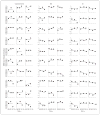Longitudinal changes in white matter disease and cognition in the first year of the Alzheimer disease neuroimaging initiative
- PMID: 21060014
- PMCID: PMC3082636
- DOI: 10.1001/archneurol.2010.284
Longitudinal changes in white matter disease and cognition in the first year of the Alzheimer disease neuroimaging initiative
Abstract
Objective: To evaluate relationships between magnetic resonance imaging (MRI)-based measures of white matter hyperintensities (WMHs), measured at baseline and longitudinally, and 1-year cognitive decline using a large convenience sample in a clinical trial design with a relatively mild profile of cardiovascular risk factors.
Design: Convenience sample in a clinical trial design.
Subjects: A total of 804 participants in the Alzheimer Disease Neuroimaging Initiative who received MRI scans, cognitive testing, and clinical evaluations at baseline, 6-month follow-up, and 12-month follow-up visits. For each scan, WMHs were detected automatically on coregistered sets of T1, proton density, and T2 MRI images using a validated method. Mixed-effects regression models evaluated relationships between risk factors for WMHs, WMH volume, and change in outcome measures including Mini-Mental State Examination (MMSE), Alzheimer Disease Assessment Scale-Cognitive Subscale (ADAS-Cog), and Clinical Dementia Rating Scale sum of boxes scores. Covariates in these models included race, sex, years of education, age, apolipoprotein E genotype, baseline clinical diagnosis (cognitively normal, mild cognitive impairment, or Alzheimer disease), cardiovascular risk score, and MRI-based hippocampal and brain volumes.
Results: Higher baseline WMH volume was associated with greater subsequent 1-year increase in ADAS-Cog and decrease in MMSE scores. Greater WMH volume at follow-up was associated with greater ADAS-Cog and lower MMSE scores at follow-up. Higher baseline age and cardiovascular risk score and more impaired baseline clinical diagnosis were associated with higher baseline WMH volume.
Conclusions: White matter hyperintensity volume predicts 1-year cognitive decline in a relatively healthy convenience sample that was similar to clinical trial samples, and therefore should be considered as a covariate of interest at baseline and longitudinally in future AD treatment trials.
Figures



References
-
- Jeerakathil T, Wolf PA, Beiser A, et al. Stroke risk profile predicts white matter hyperintensity volume: the Framingham Study. Stroke. 2004;35(8):1857–1861. - PubMed
-
- DeCarli C, Miller BL, Swan GE, et al. Predictors of brain morphology for the men of the NHLBI twin study. Stroke. 1999;30(3):529–536. - PubMed
-
- DeCarli C, Murphy DG, Tranh M, et al. The effect of white matter hyperintensity volume on brain structure, cognitive performance, and cerebral metabolism of glucose in 51 healthy adults. Neurology. 1995;45(11):2077–2084. - PubMed
-
- De Groot JC, De Leeuw FE, Oudkerk M, et al. Periventricular cerebral white matter lesions predict rate of cognitive decline. Ann Neurol. 2002;52(3):335–341. - PubMed
Publication types
MeSH terms
Grants and funding
LinkOut - more resources
Full Text Sources
Medical

